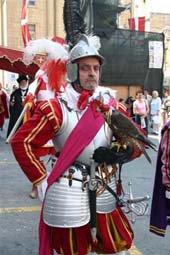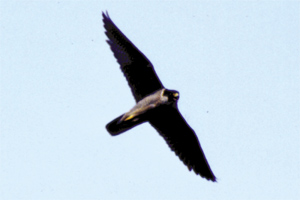The world is a mask that hides the real world.
Thatâs what everybody suspects, though the world we see wonât let us dwell on it long.
The world has ways - more masks - of getting our attention.
The suspicion sneaks in now and again, between the cracks of everyday existenceâ¦the bird song dips, rises, dips, trails off into blue sky silence before the note that would reveal the shape of a melody that, somehow, would tie everything together, on the verge of unmasking the hidden armature that frames this sky, this tree, this bird, this quivering green leaf, jewels in a crown.â¦
As the song dies, the secret withdraws.
The tree is a mask.
The sky is a mask.
The quivering green leaf is a mask.
The song is a mask.
The singing bird is a mask.
Thursday, December 01, 2005
lament for the Maltese falcon

Wildlife conservation in Europe: Lament for the Maltese Falcon
Every year, around two million wild birds are massacred on Malta as they migrate from Europe to their winter quarters in Africa. Some species, such as the peregrine falcon, have now disappeared from the island altogether. The European Union has the hunters in its sights, but as Anne Penketh reports from Valletta, they are proving an elusive - and defiant - quarry
At the entrance to the Buskett bird sanctuary in Malta, a notice warns visitors that "no hunting or trapping is allowed within the nature reserve" and gives them a telephone number to report violations. Less than 200 yards away lies a red spent cartridge, proof that Maltese hunters are prepared to risk being reported to the police by shooting their prey in one of the island's few protected zones.
Hunting birds has been part of Maltese life for hundreds, if not thousands of years. "Go to the port, how many seagulls do you see? None - that's because they shot them all," says a shopkeeper in the capital, Valletta.
He is not joking. Every year, according to the bird protection society BirdLife Malta, up to two million birds are massacred on Malta, which lies in the very centre of the migratory route between Europe and Africa. Other estimates put the death toll much higher. There are 12,500 registered hunters and 4,300 trappers on an island with a population of 400,000 crammed onto its rocky outcrops. They trap finches for breeding and sale, and shoot anything that flies, from birds of prey to quail and skylarks. Some, like thrushes and turtle doves, end up on the dinner table, others are kept caged on rooftops, but most are stuffed as trophies and displayed in cabinets by the hunters for bragging rights. In Malta, they shoot swallows for target practice.
But now the European Union has the hunters in its sights. Since Malta joined the EU last year, it is supposed to have implemented the EU's Birds Directive, which protects birds and their habitats throughout Europe, and regulates bird hunting. It notably bans trapping, and forbids the hunting of birds on their way to breed and during the breeding season.
But the country's hunting lobby is powerful. In an attempt to keep the hunters' vote in the run-up to Malta's referendum on EU membership, the government promised it would preserve turtle dove and quail hunting in spring - the height of the shooting season, when hundreds of thousands of birds return to Italy and the Balkans from Africa.
Malta has one of the shortest close seasons in Europe, from 22 May to 31 August, but even that is rarely observed. It was only in 1980 that the government enacted laws to control hunting, and set up the protected zones. But for many years they were ignored by the hunters, and not enforced by police.
The president of BirdLife Malta, Joseph Mangion, says the situation in the reserves has improved over the past five years, but elsewhere illegal hunting is rife. The shooters, who have resorted to vandalism and violence in the past to protest against hunting restrictions, "are not so blatant about it, they no longer put up hunting hides in the park". But he says that "smash-and-grab raids" are still taking place. "This past week, we had regular reports of illegal hunters in Buskett. There's been a good migration of woodcock, that's why they're trying their luck."
On the windswept, barren scrubland of the Dingli cliffs, just south of the park, the landscape is dotted with stone-built hides that stand among the cacti. Finch-trapping is another popular activity - nets are dropped on the birds, sometimes catching entire flocks. Maltese trappers who were setting out their cages last Saturday afternoon said they were waiting for greenfinches. One, dressed in army fatigues, already had a boot-load caged in his car, covered with a sheet and twittering faintly.
The sale of birds is now only permitted if they have been bred or legally imported. Illegal tradesmen have moved their market stalls from Valletta to Mdina, Malta's ancient capital further inland, in hopes of escaping the attention of the police. But they carry out successful raids from time to time. Such is the Maltese obsession with birds that some of the breeders experiment with cross-breeds, in the hope of producing the perfect birdsong.
They cross linnets, greenfinches, canaries and goldfinches, resulting in much-prized, but sterile, birds known as baghal (mule). To strengthen their song, they have to be kept with the species that the breeder or trapper wants them to imitate - otherwise, they mimic the wrong songs and become worthless.
Mr Mangion is furious about the government's foot-dragging in implementing the EU directive, and says that it cannot impose a derogation until that is done. "Our main issues are: firstly, get the directive transposed into law and implemented, which means no spring hunting and trapping. Hunting in spring is just a 'no go' for us. The deaths are too high. Hunters know they have to change their ways.
"Second, we need law enforcement and increased resources. Unless we have a good police presence, hunters won't change their behaviour."
The protected zones are currently monitored by an arm of the police, the Administration Law Enforcement section, which monitors the environment and has raised awareness of illegal hunting. But according to locals, some police are also hunters.
The hunters know they are under pressure: on Saturday they were very much on the defensive. One, wearing a woolly jumper, emerged from a hide to wave his arms aggressively and say repeatedly, "I see nothing", while another volunteered the information that he was trapping the birds for breeding before any questions had been asked.
At first glance the hunting debate seems to reflect a generational conflict in Malta, with young and urban professionals joining the Alternattiva Demokratika green party and BirdLife Malta, which now has 3,000 members under the presidency of Mr Mangion, who is a fire and security surveyor for an insurance company.
But the Maltese say that is a false impression. In fact, many young people are joining the huntsmen, buying a licence at the legal age of 18. According to Maltese experts, the damage done to the hunting culture in the past was by people who did not come from hunting families, and would fire at anything that moved. Those were the days when marsh harriers would go straight into a casserole, and when the stuffed heads of protected species would be proudly displayed by drivers on their rear-view mirrors.
Because of EU membership, the two sides in the bird war have been forced to meet. But it was not always so: in the past relations were violent, with hunters carrying out vicious protests. They have poured oil into wetlands, and punched an environment minister who then had to take on police protection.
The hunters are represented by an association now called the Federation for Hunting and Conservation. They maintain that Maltese shooters and trappers form an important part of the economic, social, cultural and political life of Malta and Gozo, "and any sportsman thus expects to exercise his legal right to practise hunting and trapping in the traditional manner, so long as he is fully aware that his harvesting does not constitute any threat to any particular species".
The association's president, Lino Farrugia, rejects what he calls the "no use" approach favoured by the "protectionists", and says the hunters stand for a "wise use" of natural resources.
The association is also concerned about precautionary measures introduced by the government to protect against bird flu, pointing out that there is no direct evidence that it is caused by bird migration. The hunters are notably fighting a temporary government ban on live decoys of golden plovers in the wetlands, aimed at preventing the spread of bird flu. (One of the jokes doing the rounds in Valletta contends that thanks to bird flu, for the first time nobody minds the hunters shooting.)
Malta's bird-hunting traditions have meant that entire species, such as kestrel, jackdaw, barn owl and peregrine falcon, have been wiped out. Only a dozen resident species remain, including the Spanish sparrow, but none are birds of prey. Even rabbits have been hunted almost to extinction: the rabbit stew on the menu in local restaurants is certain to have been bred.

Maltese falcon
Natalino Fenech described the history of Maltese hunting in a 1992 book, Fatal Flight: The Maltese Obsession with Killing Birds, which chronicled the annual death toll of three million finches, more than half a million thrushes, 500,000 swallows, 80,000 golden orioles, 18,000 shearwaters and 50,000 birds of prey.
Malta has destroyed its own heritage: when the island was ceded by Charles V to the Knights of St John in 1530, it was on condition that an annual rent of two Maltese falcons was paid - one to the Spanish emperor and the other to the viceroy of Sicily. Maltese falcons were reputed to be the finest of the peregrines. By the 1970s, the species had been all but destroyed by hunting. The last pair was shot off Ta' Cenc cliffs in 1980.
It may have been no accident that the bird in Dashiell Hammett's classic detective novel, The Maltese Falcon, is not a real falcon, but a statue. But in the ultimate irony, Malta's national bird, the blue rock thrush, still features on its one-lira coin.




